Ludwigia aquarium plant: types, maintenance and care
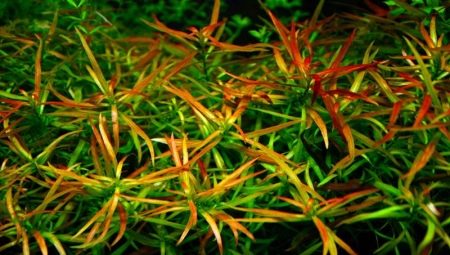
Ludwigia can be found in many home aquariums. This is a pretty plant that adorns the artificial water world, which does not require serious maintenance. There are many varieties of ludwigia, among which it is possible to choose free-floating or ground-rooted species.
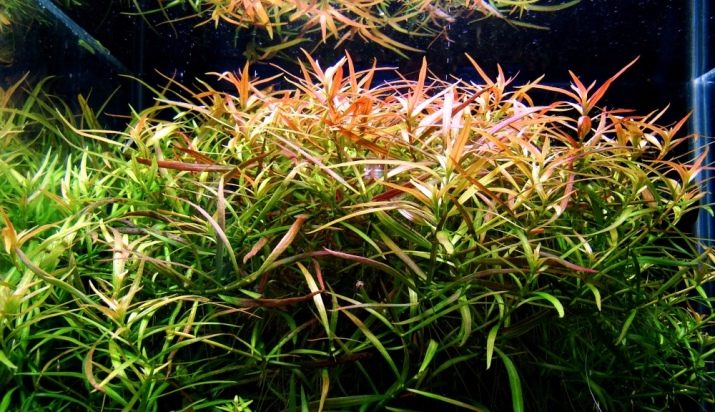
Description
The culture belongs to the Onagricaceae or Fireweed family. The various species can be annual or perennial grasses, sometimes shrubs. The native land of the plant is considered to be tropical and subtropical regions. Its stems can be found in Central and North America, in the humid regions of Asia and Africa. The plant feels comfortable in various bodies of water and can even multiply with other crops in the natural environment. Among the various species, there are specimens that survive even on land.


The plant gained its popularity in the world of aquaristics for its elegant appearance.... It is characterized by straight stems, stretching up to a height of 30-50 cm, and branched shoots with light neat leaves. The leaves are slightly elongated and light green in color. If the plant is in comfortable conditions for it, then the leaves are covered with a red-brown tint. Their size varies depending on the type of ludwigia. Flowering is possible above the surface of the reservoir, the plant produces yellow or green flowers with four petals.
In some countries, the crop is used as a forage plant, it can be used in medical, food and textile industries, but most often ludwigia acts as an aquarium plant. It transforms the tank, makes it more noble and well-groomed.In addition, specimens usually take root well in aquariums.
In the world of aquaristics, it is even customary to propagate this crop for sale, however, this process is not difficult.
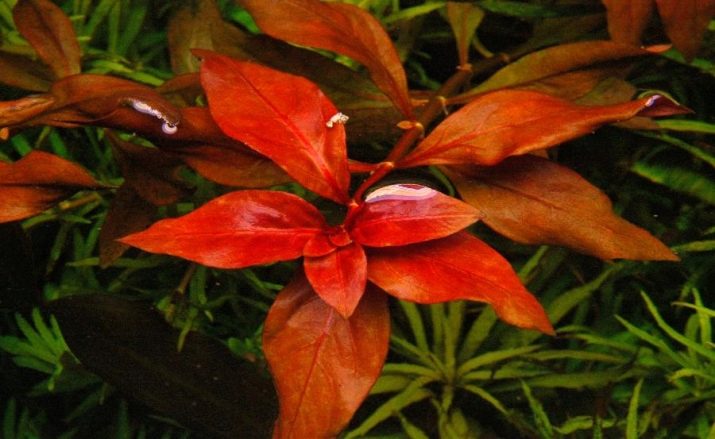
Varieties
It is worth considering the most famous varieties of ludwigia.
- Variable-leaved. It is a perennial flowering plant native to America. It has long branching stems with lanceolate green leaves, reddish on the inside. When cultivated in an aquarium, it looks like a shrub with numerous shoots. Sometimes the upper part is on the surface of the home reservoir, where the shoots form yellowish flowers.
The species is resistant to fluctuations in water temperature, the optimal range is + 18– + 28 degrees. Lower values lead to a decrease in leaves and retardation of development.
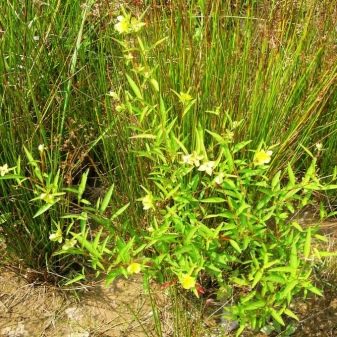

- Arcuate. It is a perennial marsh plant that can be found in eastern North America. It has slender, upright stems and paired, pointed leaves that are light green to reddish in color. The plant is a shrub with many shoots. Reproduction is possible by dividing the stem or by shoots from the base of the edge.

- Floating. This species has a well-developed root system and tough, highly branched stems. Pairwise leaves are wide, but narrowed at the edges, the upper part is green, the lower part is covered with a reddish tint. This species grows well, forming fluffy thickets. It can be propagated by dividing the stem or by side shoots. The plant grows in the south of North America.
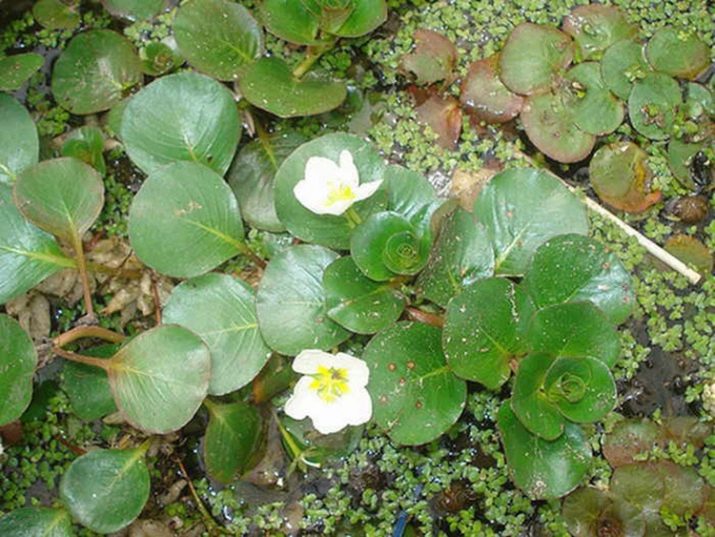
- Rdestovaya. It is considered one of the most beautiful species, especially if it grows on the surface of the water surface. The root system is a lobe of soft roots. Long stems form lateral shoots. The color of the leaves is interesting: on the surface they are green, but under water they lengthen and acquire a golden tint with pinkish veins.
In the aquarium, the plant looks very beautiful, it can bloom above the water with large yellow buds. Reproduction is carried out in a vegetative way.
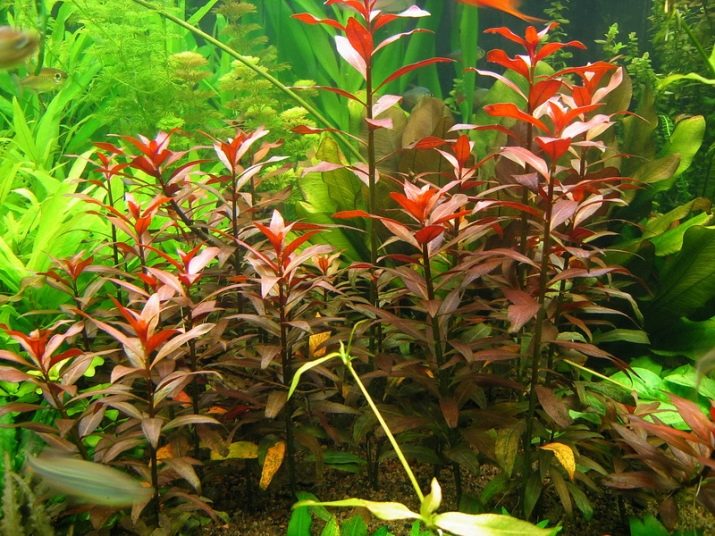
- Cushion-shaped. It is a compact crop growing in the swamps of Central and South Africa. It has a well-developed root system with many shoots. The leaves are presented in the form of an egg, the outer part of the leaf plate has a light green tint, the inner part is blush. Reproduction occurs vegetatively.
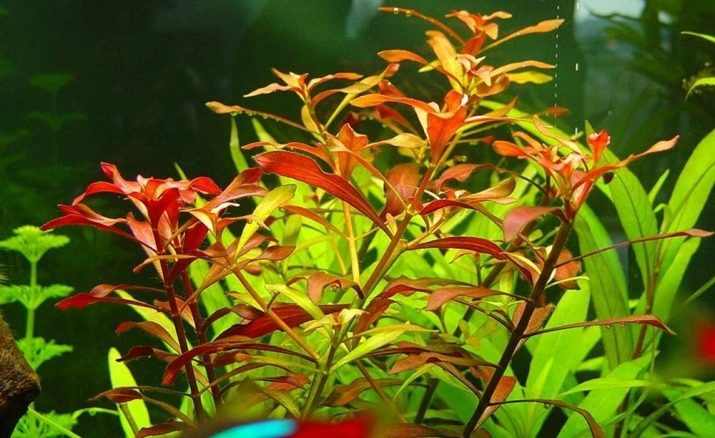
- Creeping... This species has a fibrous rhizome and rounded long stems. Petiole leaves can be oval or rounded, the upper part is dark green, the lower is reddish. When flowering, the plant forms unattractive miniature flowers.
Planting is recommended in the central or rear part of the aquarium at a water level of no more than 40 cm. The desired temperature range is + 18– + 28 degrees.
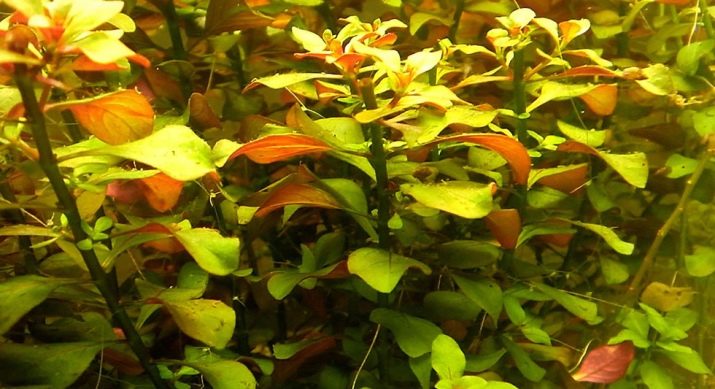
- Swamp. You can find this variety in Europe. It has the longest and most branched stem. The upper part of the leaf blade has an olive shade, the lower one is reddish-purple in color. Blooming in aquarium conditions is not excluded.
In general, the plant is unpretentious, withstands transplantation and a sharp change in temperature, but for aquarists it is not of particular decorative interest.

- Glandulose Peruvian. Sometimes this variety is called glandular ludwigia. It is characterized by a thick stem and erect growth. The leaves are narrow, pointed, have a bright pink-red color, which slightly loses its saturation under water.
This species grows slowly, has high requirements for keeping at home.
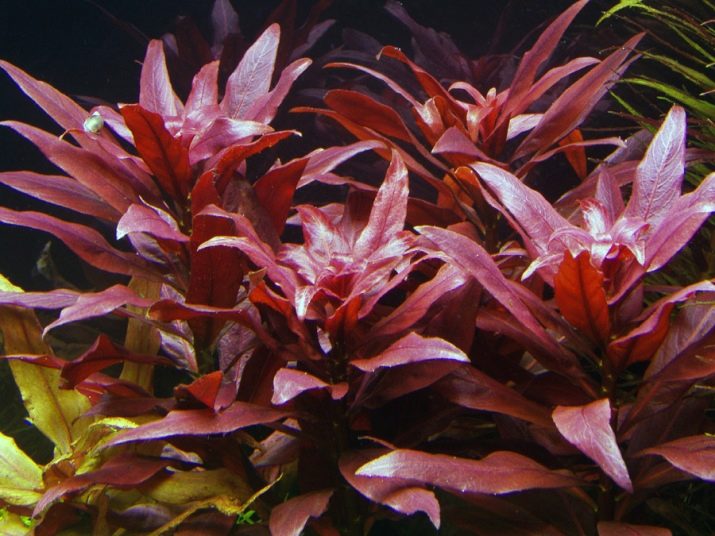
- "Ruby". This species is native to South America. It refers to Ludwigia creeping in shape. The stems are brownish in color, the pointed leaves are painted in reddish shades. Flowering is characterized by the appearance of green-yellow buds.
Growing requires well-prepared living conditions.If the color begins to fade, then it can be assumed that there may be a lack of lighting in the aquarium.
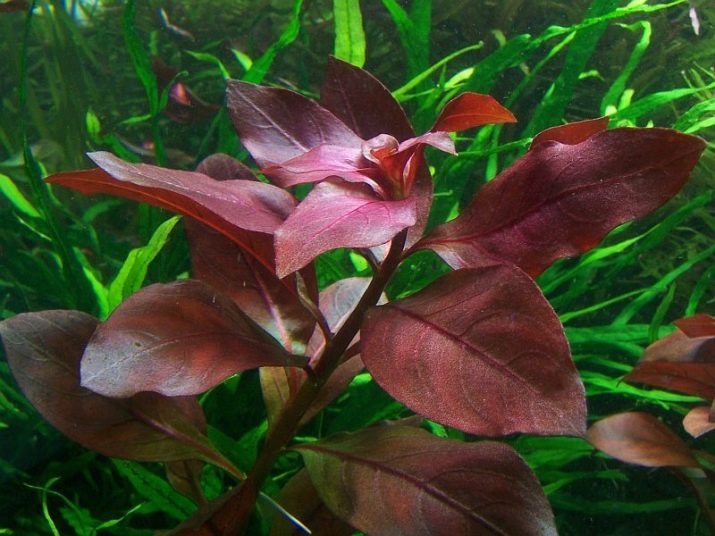
Compatibility
Not all plants can be planted in a shared aquarium. Also, you should not plant Ludwigia in containers with certain types of fish. For example, it is not recommended to grow this crop in an aquarium where there are fish that like to dig in the ground. These include, for example, cichlids. Such fish, with their habit of digging in the ground, can damage the rhizome of ludwigia, which will negatively affect the development of algae.
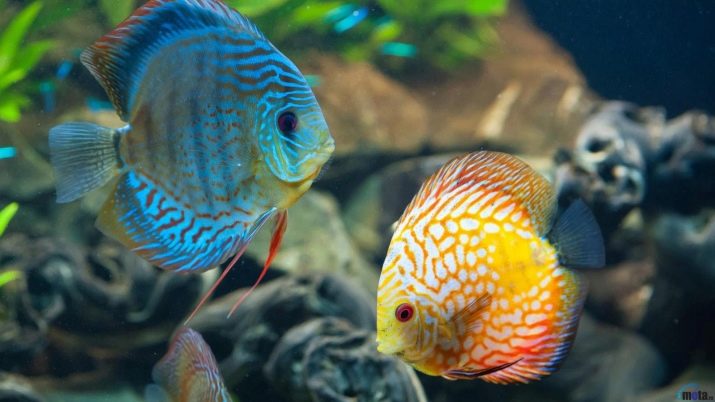
As for other types of herbs, here you should select plants, the conditions of which are similar to those for ludwigia. So, this culture loves bright lighting, and this is not always good for other plants. Besides, it is important to plant herbs in the aquarium that will not overgrow and block the light for ludwigia. Avoid large-leaved green spaces.
In addition to the decorative function, ludwigia also has a practical function. For example, it can become a refuge for schools of fry or small fish such as guppies, gourami, mollies. Some aquarium inhabitants are not averse to feasting on its healthy leaves, enriched with vitamins.
In addition, like other plants, ludwigia produces enough oxygen in the water, so it is suitable for planting in an aquarium with almost any type of fish.
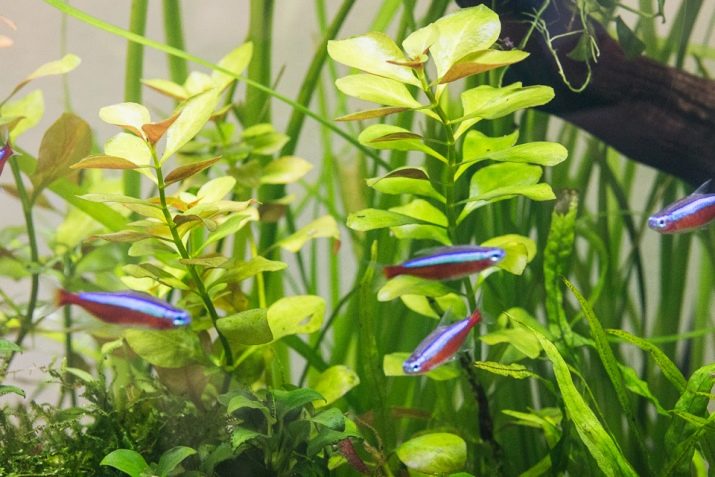
Growing conditions
When growing ludwigia, pay special attention to the choice of soil. It should be a nutritious substrate, for example, a moderately silted variety. Add clay balls to the fresh soil - they will serve as a kind of fertilizer for the crop. Fine gravel poured into the tank at a level of 3-4 cm is suitable as a soil. Do not take stones of a large configuration, otherwise the plant will damage its fragile roots.
Prepare the water that has settled during the day with the following indicators: acidity - 6.5-7 pH, hardness - 5-6 dH. There are species that feel comfortable even with greater rigidity. The most favorable temperature indicators are + 22– + 27 degrees, but the permissible temperature is within + 16– + 29 degrees. If the water temperature is too low, then growth is inhibited. Some species are capable of shedding leaves or sore at low rates. Too high a temperature provokes stretching of the stems, which greatly spoils the harmony of the aquarium decorative composition.
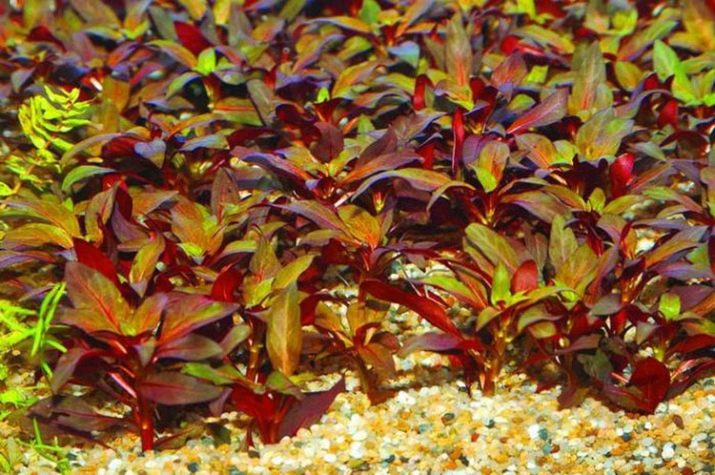
Keep the water in the tank clean, since Ludwigia feels uncomfortable with the turbidity of the aquatic environment. In dirty water, build-ups and sediment can form on the surface of the leaves - this indicates the need to change the water. Standard aquarium maintenance includes a weekly change of 1/3 of the volume of water. And also do not forget to get a good filter and aeration systems - these units also ensure the purity of the water in the tank and its enrichment with oxygen.
Daylight hours should be about 12 hours. Install powerful lighting fixtures that will benefit your culture and prevent algae growth. Choose conventional incandescent and fluorescent lamps as artificial lighting. They are used in case of cloudy weather, as well as in situations where sunlight does not hit the aquarium. Of course, natural light cannot be replaced by anything, the sun's rays accelerate metabolic processes and improve photosynthesis, but in most cases, aquariums should not be placed in the sun, as this provokes the growth of harmful algae, for example, filamentous algae, so artificial lamps cannot be dispensed with in aquaristics.
The plant can be fed. A small amount of mineral fertilizer containing iron will make the color of the leaves more colorful and vibrant. Under the influence of additional nutrition, the leaf plates of some species will be covered with a beautiful dark red tint.Plant the plant in lighted areas, otherwise it will quickly wither in the shade.
It is not recommended to root the culture in the center of the aquarium, as it will interfere with the pets, but if the owner still planted Ludwigia in the middle, then it should be pruned periodically.

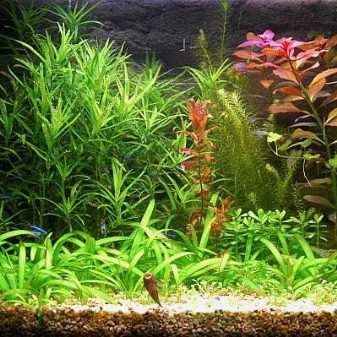
Reproduction and transplantation
There are usually no problems in reproduction. The presented culture takes root well at home. For example, you can breed it by grafting. To do this, carefully cut off the top of the stem with sharp scissors and plant cuttings 8–10 cm long in the ground. Let it be a sufficiently illuminated area where the shoot will firmly take root and soon give rise to roots. Some aquarists leave cuttings on the surface of the water, in which case the shoot also produces roots.
For young samples, you need to choose a high-quality substrate or a special substrate with a set of substances that the sprout needs. To grow a lush shrub, 2-3 leaves are pinched off a strong stem, in place of which, after a short time, new shoots will appear. Ludwigia is rather indifferent to transplanting. The procedure is carried out in case of changing the aquarium or in order to change the decorative composition. For transplantation, the bush is carefully removed from the soil along with the rhizome. In order for the specimen to take root without problems and quickly adapt to new conditions, when diving from the root, pinch off the tip.

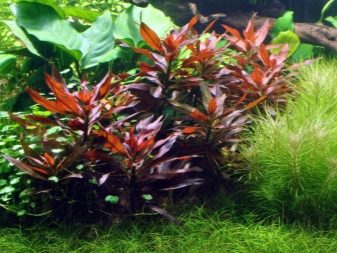
For more information on the features of ludwigia, see the next video.








